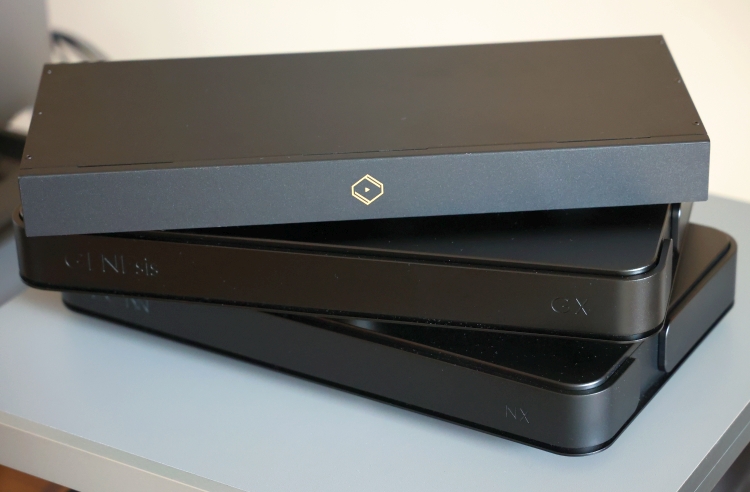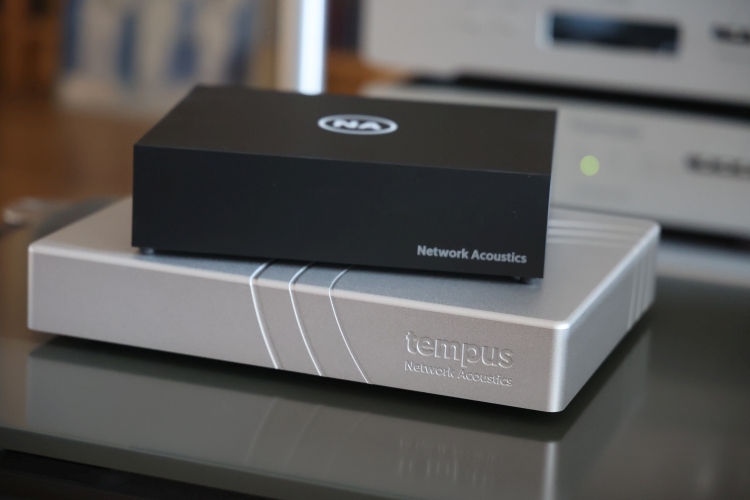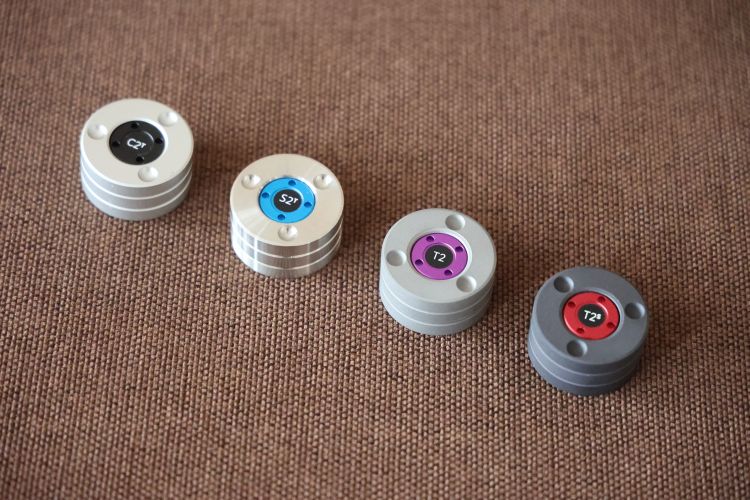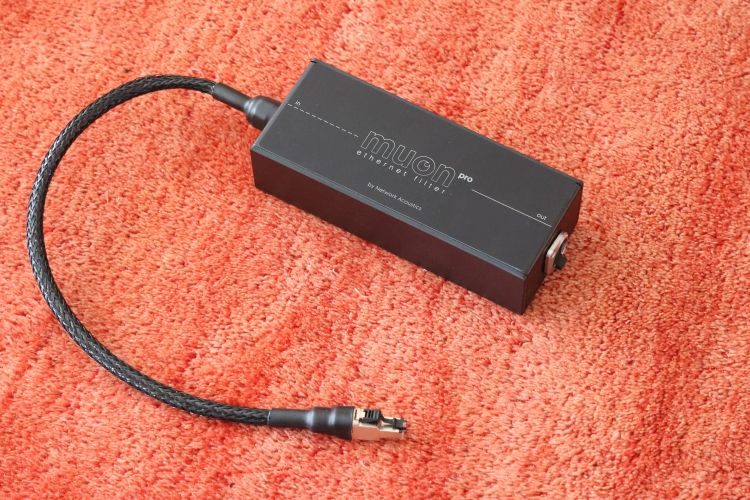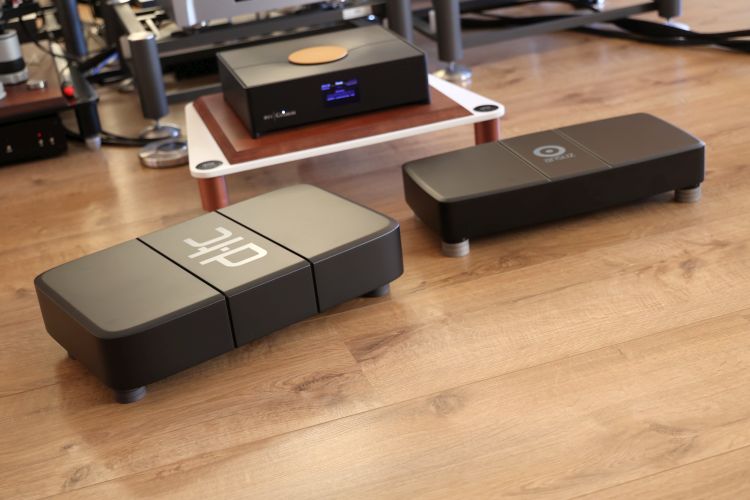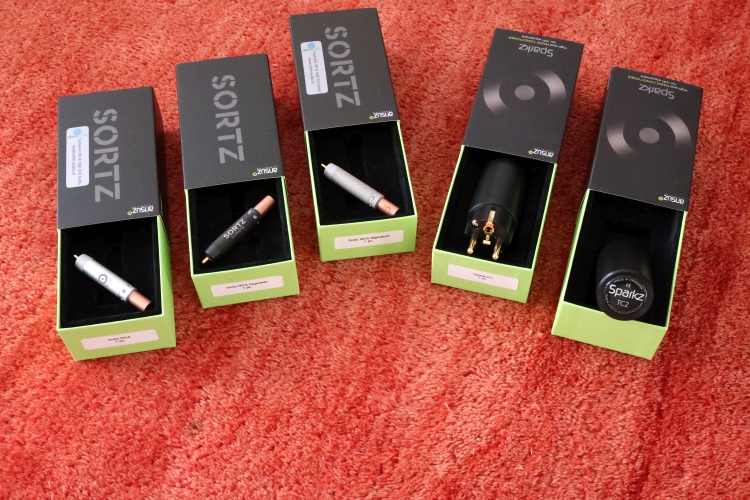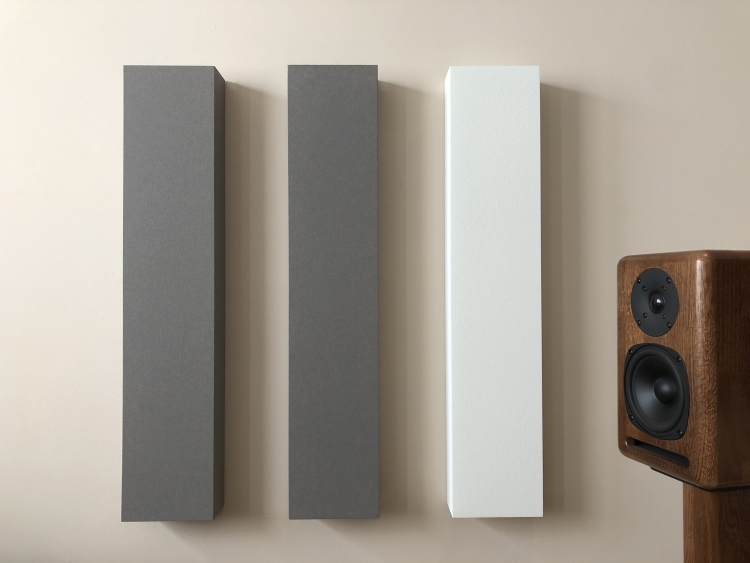Mad Scientist Audio CanOpeners and BlackDiscus
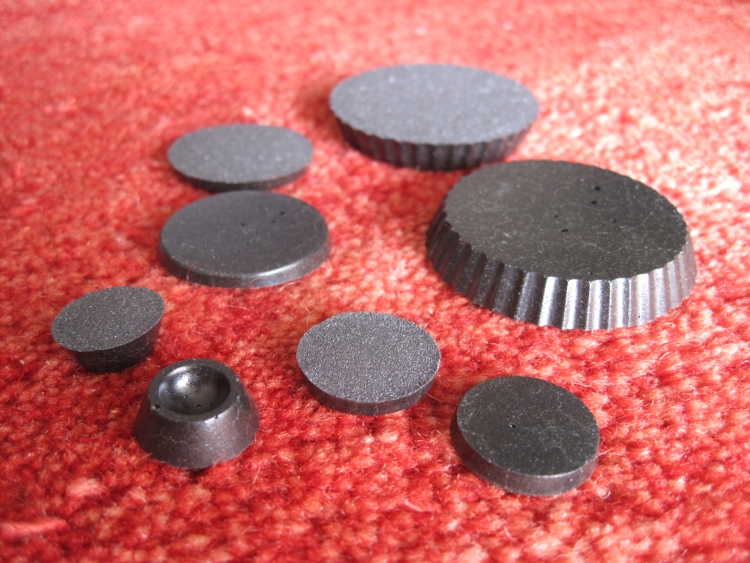
Unassuming tweaks that really work
This review was carried out over a longer timespan than usual and during the course, the manufacturer brought out a new range of products with a different name, based on similar but improved technology. Because of this, the review covers two products from the same company: CanOpeners and BlackDiscus. Catchy names, no?
Review samples kindly supplied by Mad Scientist Audio
Retail prices:
CanOpeners Retail price: $49 – $99 per set of two
BlackDiscus Retail price: $19 – $49 per piece
Rebate if buying multiples. Free blackdiscus sample. 30 day money back guarantee.
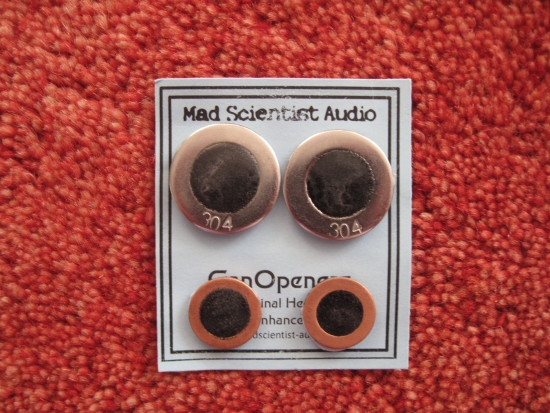
Background
The first samples of Mad Scientist products that Bob Prangnell sent me were the CanOpeners. They were squarely aimed at headphone users and this is how I tested them. Along with the CanOpeners, Bob had included something new he was working on: the CupCakes.
Why do they work? Or, more importantly: how do they work? I don’t really know. Bob has some explanations:
The black-stuff is made from epoxy and a mixture of minerals. But the secret is in the processing. It takes several hours for the composite to cure, and during this time it’s subjected to a variety of fairly extreme things. I built a rig, computer controlled, that does most of the processing (but there is some manual intervention as well). This contains, among other things, what could be described as a mini particle accelerator. It uses tens of thousands of volts (this part really sounds like mad science, as it crackles and hisses while running). There’s one process that affects the interior of the device, and there’s another process that affects the surface (the rough surface).
If you just take a raw BlackDiscus and do not put it through the processing, you get something that looks exactly the same, but has no effect on audio systems. In fact, we have used such discs in our blind testing, as the dummy. Incidentally I was testing them against ferrites, like the ones you clip over leads on computer stuff. Boy they sound horrible (the ferrites I mean ;). I think it’s because the ferrites just reflect RF, not kill it, whereas these things do something to actively kill it. They don’t work like normal RF absorbent material – there’s still some unanswered questions.
Also interesting is that if I make a BlackDiscus with only one or other of the processes (surface, interior) there is almost no effect – implying that both processes are needed.
After the composite has cured and the high-energy processing is done, they are heat treated (why ? because it makes them sound better! How do I know? Blind testing…so you see, I am pretty scientific about this.)
If you think of them as an RF-disrupter you get the idea.
Now, I am not much of a headphone-fan. I have several headphones and have listened to some very good and expensive ones, but I just don’t really like having the sound sit right on my head. I like my sound big and spacious, and at some distance, which is why I prefer Apogees and Magnepans. That said, I know that it can be very difficult indeed to match the natural, low-distortion, transparent and uncoloured sound that headphones are capable of with such ease. So, I accepted Bob’s offer and after doing some tests by myself (using headphones in the range of 80-120 euro and a Yamaha DSP-Z7 cinema amp), I took them to a friend with a much more serious headphone setup. While still not state of the art, I think few people could argue with the following system: AAZ Ultra Flow music server, into a Jeff Rowland Aeris DAC, into a Musical Fidelity X-Can v3 (with upgraded power supply), using Sennheiser HD650 headphones.
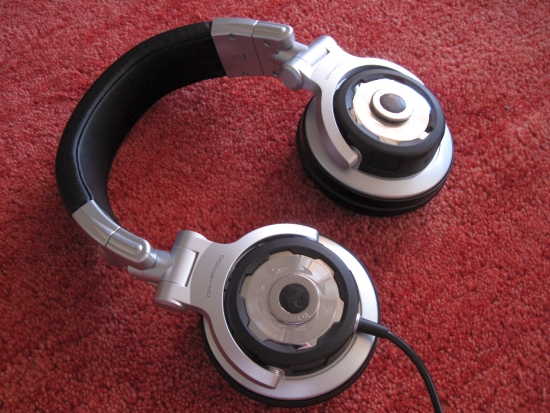
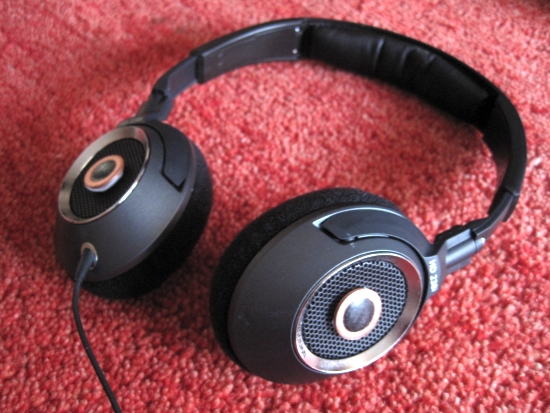
Above: CanOpeners on my own headphones. I also tried them on other places of the phones, like on the headband, with similar results. Orientation therefore does not seem to be of a huge influence.
CanOpeners – First listening
Using borrowed Denon DJ headphones (type escapes me), Sennheiser HD238i and cheap Sennheiser HD437 I carried out some first tests, plugging the headphones into my Yamaha DSP-Z7 cinema amp. The phones certainly aren’t top-bill but the amp is very good, for cinema use and using its speaker outputs at least. Somehow, using its headphone output did reveal subtle differences, but they were by no means as large as the differences that I would later hear in a more serious setup at a friend’s place.
After A-B’ing several times, using the 3 headphones described above, I had the effect pinned down, but it was very small. With CanOpeners, the sound was more spacious and frequency extremes seemed somewhat pronounced while the midrange was slightly warmer. The bass was fatter but also woolier. Overall, I could explain the effect as being similar to what Transparent Audio (Ultra XL) interlinks sound like, compared to standard cables, but less pronounced overall and I wasn’t sure what I preferred: with or without. This was not a very convincing start and I even contemplated not writing a review at all, so I informed the manufacturer and he asked me what gear I was using. I had to admit that my ‘phones and associated equipment couldn’t really be taken seriously so off I went, to a friend with a decent headphone setup.
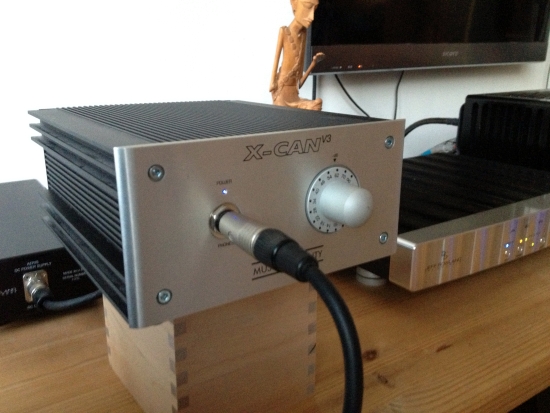
Above: Niels’ headphone setup: AAZ Ultra Flow music server, into a Jeff Rowland Aeris DAC, into a Musical Fidelity X-Can v3 (with upgraded power supply), using Sennheiser HD650 headphones.
The good thing about being with a second person is that there’s a second opinion. Also, it allows for blind testing. I did this by attaching different versions of the CanOpeners to the headband, while my friend Niels was listening, and couldn’t see which versions I attached. Naturally I also listened myself, with Niels doing the swapping-honours. The interesting thing is that sometimes we’d attach a different conclusion to what we heard, but we always heard the same thing.
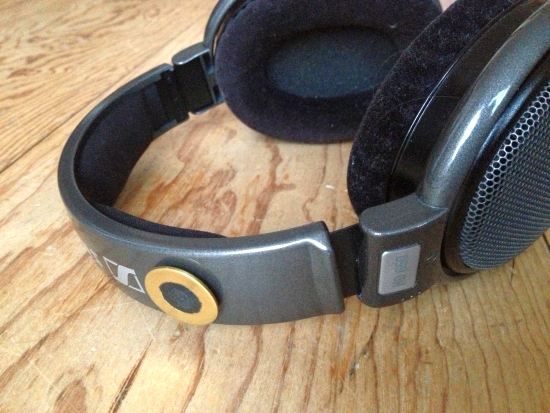
Above: We tried several positions but they didn’t seem critical to the effect, so I settled on using them on top of the headband: one on each side of the brand name.
Because the original CanOpeners have now been discontinued, it isn’t much use describing the whole process in great detail, but given the interesting results, I think it is still worthwile to report in short what we heard. I had several versions of the CanOpeners: Copper and Stainless Steel in 2 sizes. As it turns out, not only the material matters, but the size as well.
From no CanOpeners to the Big Copper CanOpeners:
More Transparent Cable-esque sound, as in more luxurious, slightly softened on bass transients but also more spacious, with smoother treble and midrange and seemingly more wide-range. More ambience and rough edges are lessened. The effect is very pleasant and the sound without them is drier, thinner and seems a little boring by comparison. In effect, I don’t have the impression that I hear more detail, but the sound is presented differently, in a more interesting manner.
From Big Copper CanOpeners to small Steel CanOpeners:
A lighter balance, seemingly more open in treble and lower midrange but also verging toward a synthetic sound, and reminiscent of the sound of the bare headphones but with more pronounciation in the treble. Somehow, the sound of the Copper CanOpeners added a warmth that is now lacking.
From Big Copper CanOpeners to the Big Steel CanOpeners:
As we suspected by now (confirmed in blind tests) the copper ones do indeed sound warmer and more pleasant. The steel ones can have hard treble.
From Big Steel CanOpeners to small Steel CanOpeners:
The smaller one seems to be better balanced, more like headphones au natural with added benefits of a more spacious CanOpener sound. The advantage of the Steel versions is that the sound is more open overall than with the Copper versions, making the latter less of a match with the already warm-sounding HD650. Still, the copper ones have a naturalness that is very appealing.
From Small Copper CanOpeners to small Steel CanOpeners:
Less difference than with the other comparisons, but the copper ones seem to sound easier on the ear. But we weren’t sure that it wasn’t suggestion.
Below is an email from a CanOpener customer, included for the writer’s interesting view on headphone listening. I wasn’t until I completed my own test that I read it, and as it turns out, we have some common ground…
Headphone listening is the equivalent of a bastard child in audiophiledom. A true audiophile would never consider headphones viable. Sure, if your honest with yourself you’d consume music through any transducer. Not because your desperate, but because in addition to being a lover of sound, your a music lover, think of your car stereo. It’s not HiFi by any stretch, but damn if you can’t rock out to it. So the ends do justify the means. So why the stigma against headphones?
Well if you compare the size, stage, and density of sound from a top notch speaker rig to a top notch headphone rig the speaker wins. Headphones however win on technicalities, directness and transparency. That’s what happens when you strap diaphrams a quarter inch from your ear. But what about those other qualities? Soundstage, ambiance and the “you are there” factor should still be present in a great system, speaker or headphone.
I’ve owned headphone rigs in the $1,500 to $3,000 range and heard everything else, including a few $10,000 headphone rigs, from the king of dynamic headphones the Sony MDR-R10, and others like the ATH-L3000s, HE-6s, HD-800s, 650s and Stax SR-009 and 007s. They all do amazing things, but none ever brought me as close to the music as Bob Prangnell’s aptly named Can Openers when mated to something like my $250.00 HiFiMan HE-300s. These little devices are just what the doctor ordered to cure headphones of any short comings speaker oriented folks might have. The sound stage explodes, instrumental differences widen and a spooky sense of reality sets in.
I’ve never really liked live recordings. They usually sound off and disconnected. But with the Can Openers in place, the venue opens up, tonal colors thicken and details rise to the surface. Listening to the 25th Anniversary recording of Les Mis I can close my eyes I swear I’m at the Fox Theater in Atlanta hearing the performance live. Except my listening chair is more comfy with no gum stuck to the bottom. I get all the cues from walls, floor and ceiling, but rather than stifle the performance they properly frame it. Without the Can Openers those artifacts strangle details and I’m left with a hollow presentation that’s just plain awful. Put back in the Can openers and things get more real. Spooky real.
… Before Bob sent me these little jewels, the best I had heard this reproduced were with two awesomely expensive rigs, one built around the R-10 and one around the SR-009. The R-10 rig was warmer and rounder, the SR-009 more lit up and technical. Placing the Can Openers on top of my HE-300 cups did both sounds simultaneously. I didn’t long for either top notch can, as mine had been properly opened. Neither wallet crushing statement headphone attracted my attention further. Sure the R-10 might have more natural tone, and the SR-009 might separate images better, but just. They don’t blow my enhanced rig away, nor do they put any quality of my system into a far lower league. Given the chance to own a sound signature between the three, regardless of cost or pride of ownership, I’d choose mine every day of the week. How’s them apples!
– An anonymous self-professed headphone nut who owns more than 12 pairs –
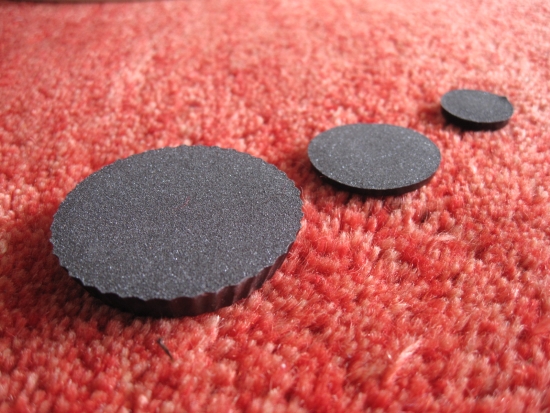
BlackDiscus
BlackDiscus is the new range of products from Mad Scientist Audio, replacing the CanOpeners. The new units come in three sizes, from small to large: Mini, CanOpener and CupCake. For this review I tried the smallest and largest versions in several positions: on the Rowland Aeris DAC’s power supply, on the transformer section of the Rowland poweramps and on the USB cable connecting the AAZ Ultra Flow music server to the Jeff Rowland Aeris DAC.
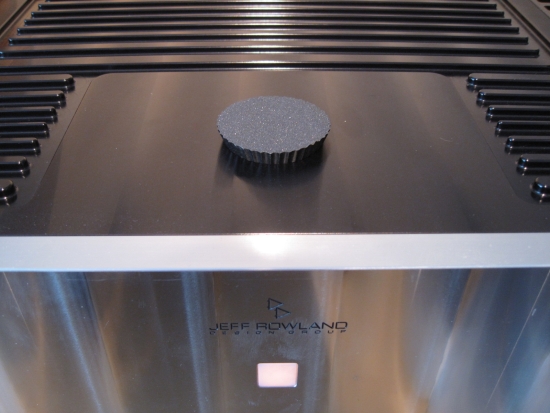
BlackDiscus CupCake On the Model 6 power amps
The effect when used on the model six power amps is far from subtle and easy to hear within seconds: midrange becomes warmer and less shouty, bass is more rounded and treble is more fluid. Overall the effect is of a warmer, more analog sound. The effect, like with the CanOpeners, is still reminiscent of what happens when swapping standard interlinks for Transparent Audio cables, but this time it is more akin of the Reference XL series for their fuller, warmer sound.
From memory, the overall BlackDiscus effect is also somewhat comparable to what the Shakti Stone does, but seemingly larger. Actually the effect is so clearly audible that I’d bet that it is evident in all but the most crudest of systems. For my system the effect is too large – thickening the sound too much and dulling bass transients in the process.
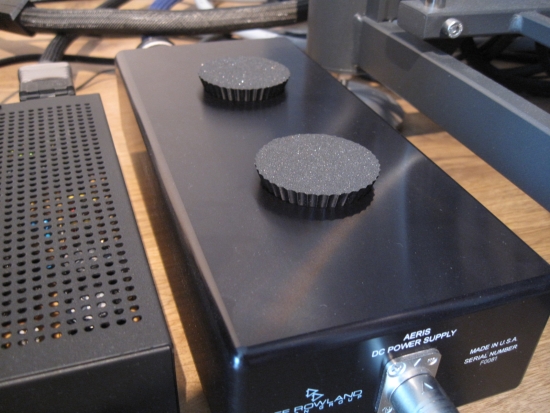
BlackDiscus CupCake On the JRDG Aeris DAC’s power supply
This is also very effective and in my setup has a more subtle effect than when used on the power amps. The overall effect is still that of a gentle smoothing of sound, reducing agression, but it is now less focused on the (lower) midrange and more on the high midrange and treble. Bass and speed seem less impacted and for my system, this is a better match because my setup is already carefully balanced and the CupCakes just do a little bit too much. This is not their fault, as similar things happen with several other tweaks like the Reference Tweaks Miracle Wraps, the Akiko GEMs and the Shakti Stone. My system apparently has little inherent agression, and when reducing it by means of such tweaks, I tend to feel that some liveliness and PRAT also disappears from the system.
Does size matter?
Substituting the CupCakes for the Minis on the power amps (where the effect in my setup is largest) does indeed shift the balance. The Minis have a lighter touch, seemingly affecting treble and midrange more than the lower midrange and bass. Midrange stays firmer with the minis – the Cupcakes having much more effect there, resulting in a warmer, fuller sound, compared to the more neutral Minis. For me, the influence of the Minis better matches my setup and taste because the bass remains tight and articulate but there a gentle relaxation that’s added, along with a smoother treble.
If there’s an edge, or even agression, then it is reduced, which can be very welcome with lesser recordings. Still, removing the Minis makes for the tightest bass and best dynamics. It also makes for the driest sound, which isn’t strictly more pleasant. For my setup however, it seems that it works best without such tweaks, simply because my setup isn’t agressive by nature, and of course because of the Transparent Audio cables already present.
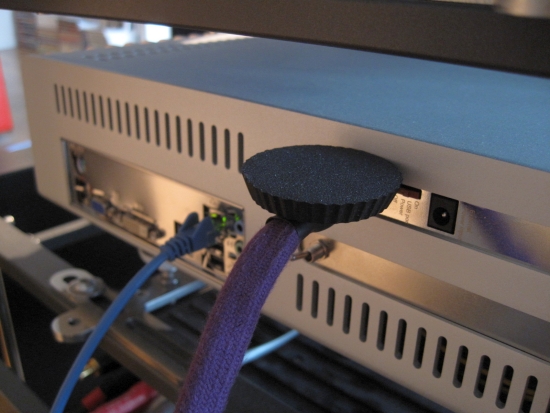
BlackDiscus Conclusion
One might think that the effects of tweaks like the BlackDiscus is only so pronounced because my setup has so much resolution, making it becomes easier for me to hear but that’s not entirely the case – I’ve also listened to the CupCakes in a friend’s setup. He uses Martin Logan Arius speakers with a Jeff Rowland Concentra II and an Aeris DAC, with an AAZ Ultra Flow server as source. Still far from entry level I admit, but because he has two young children, he has spent far less time perfecting his setup. As a result, the speakers are in different positions depending on the day you visit and because his wife doesn’t like hifi-looking furniture, he is stuck with a simple wooden table. So, a very good system, limited by the speakers, WAF and lack of spare time. Still: in this system it was also very, very easy to hear the effect of the BlackDiscus CupCakes, the effect being the same as in my setup: a warmer, more full-colour sound, with less lean midrange and treble. It’s that I don’t own a more normal system but I suspect that the CupCakes will work wonders in systems that use horn-speakers, or Sonus Fabers or other less than polished sounding speakers.
CanOpeners Conclusion
Copper versus Stainless Steel is easy to hear. Copper sounds warmer but is also a little fat on the bass. Stainless Steel sounds more open and articulate throughout the frequency range (bass also) but has an emphasis on the treble and can therefore sound hard. Size is more difficult to pin down. If anything, it seems that the effect is larger when the size of the material is larger, for better or for worse. For example: we found that the smaller steel versions sounded better-balanced, less extreme than the large ones. But the outcome isn’t consistent as the small steel ones were preferred to the large steel ones but for the copper ones we preferred the bigger ones. No matter what you think of the results, the important thing is that they do indeed have quite a profound effect on the sound. It was very easy to hear the presence of any version CanOpener on the headphones, or on the headphone cable connector indeed. The difference between the versions was still audible but more difficult to pin down. By the way: Niels, the friend whose headphone system we used for testing, held on to the CanOpeners – he didn’t want to listen without them anymore.
External Links
Manufacturer: Madscientist.com
